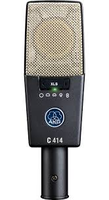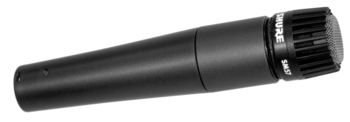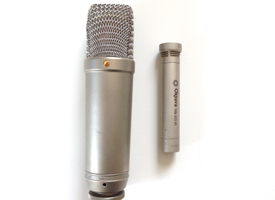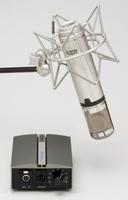If you're not sure of the difference between condenser mics, ribbon mics, and dynamic mics, or what a polar pattern is, here’s a quick overview that will get you up and running when it comes to microphones.
Pick a type
Let’s start by looking at the three most common mic types used in recording studios:
Condenser mics (aka “capacitor mics”) are the most prevalent studio microphones, and range from cheapo electret models to high-quality mics that have been used on countless recordings.
Condensers are often chosen for recording vocals and acoustic instruments, thanks to an ability to accurately reproduce a wide frequency range, and offer good transient response (the capability to accurately capture instruments such as cymbals, snare drums, strummed acoustic guitars, etc., which are sounds that have sharp initial attacks). Condenser mics require power to operate, and while some run on batteries, most use 48V phantom power, which is supplied by mic preamps, audio interfaces, and mixers, and gets to the mic via the XLR cable. Condensers are more fragile than dynamic mics, so aren’t used as much for live performance. The image to the right is the AKG C414 B-ULS, a popular and versatile condenser mic.
Dynamic mics capture sound electromagnetically and don’t require external power. They’re quite rugged, which is why they’re the most prevalent mics in sound reinforcement. In the studio, dynamics mics like the classic Shure SM57 pictured to the left, are typically used for drum miking (except for the overhead mics, which are usually condensers) and on guitar and bass cabinets, but are not considered particularly good for recording vocalists. They don’t reproduce high frequencies or transients as well as condensers, so are not ideal for acoustic stringed instruments.
Ribbon mics get their name from the super-thin ribbon element inside them that is the key to their sound pickup. Like condensers, they capture a wide frequency range, but they typically provide a sound that’s warmer and rounder, though not as crisp. Older models were super fragile, but contemporary ribbon mic designs are more robust. This Royer R-121 (right) is one of the most well-respected ribbon mics among engineers and producers.
You don’t see ribbon mics too often in home studio setups because they’re expensive. Although you can buy inexpensive ribbon mics in the sub $300 range, I wouldn’t recommend them. You get much better value for your money in that price range with a condenser mic.
Ribbon mics are great on guitar cabinets, piano, brass, and vocals, among other applications. If you have a high-quality ribbon mic, you might use it for many of the same applications you’d use a condenser for.
Size does matter
Microphones come in a variety of shapes, but generally are classified as being either large-diaphragm or small-diaphragm models. This is based on the size of their diaphragm, a small piece of material inside the capsule that vibrates when hit by sound waves, and whose vibrations are turned into electrical energy by the mic’s circuitry. Both large- and small-diaphragm mics have their own sonic characteristics, and there own pros and cons. (To the left you see a large diaphragm Røde NT1A next to a small-diaphragm Oktava MK-012–01.)
Although it seems somewhat counter-intuitive, small-diaphragm mics pick up a wider frequency range, making them often a better choice on instruments with a lot of high-end information, like steel-string acoustic guitars and other stringed instruments, for example. However, their operation generates more noise (called self-noise), than does a large diaphragm mic. Large-diaphragm mics are more sensitive. That means they pick up sound more easily and therefore have a higher output. On the downside, they’re more prone to being overloaded by a loud source, which could add distortion to the signal. A mic’s ability to handle volume is measured by it’s sound pressure level handling spec (SPL).
While there are no rules, large-diaphragm mics are more typically used on vocals and small-diaphragm mics on instruments. Some of the most legendary vocal mics, such as the Neumann U87 and AKG C12, among many others, are large diaphragm models.
Tubing it
Another consideration in choosing a mic is whether it’s a solid-state or tube mic. As a general rule, the former is going to sound cleaner and crisper, while a tube mic, which uses an actual vacuum tube in its circuitry, will offer more warmth. Solid state mics tend to be more durable. Tube mics typically come with their own external power supplies, and don’t use standard phantom power. On the right you see a Miktek CV4, a large-diaphragm tube condenser with it’s external power supply.
Notice a pattern developing?
Microphones capture sound through their capsules in one of several types of pick up (aka “polar”) patterns. Understanding the difference helps you choose a mic for a given situation. Most mics are designed with a single pattern, but multipattern mics have switchable patterns, allowing you to change the way they pick up sound based on the situation.
Cardioid: The most common pattern, cardioid mics are also referred to as “unidirectional” mics, because they pick up primarily from in front of the capsule. Besides standard cardioid, there are two other variations, hypercardioid and supercardioid, whose pickup patterns are even more focused in front.
Cardioid mics exhibit what’s called the “proximity effect, ” a build of low end on closely miked sources. This can be used to your advantage, because it makes vocals sound bigger than life. However, always use a pop screen (a circular mesh screen, which you place between the mic and the singer’s mouth) with vocalists, to avoid loud plosives, which are exaggerated consonants, especially P and B sounds.
Omni: An omni mic picks up equally from all around the capsule. If you were miking, say a group of backup singers on one mic, an omni would be a good choice as they can all stand around it and get picked up equally, which you couldn’t do with a cardioid mic. Unlike cardioid mics, omni mics are not prone to the proximity effect, so can be used in situations, like recording acoustic guitars with the mic pointed at the soundhole, which would sound overly boomy with a cardioid mic.
Figure-8: A figure-8 (aka “bi-directional”) mic picks up equally from the front and back of its capsule, while rejecting sound waves coming to it from the sides. Sometimes a figure-8 mic is the best choice because it doesn’t pick up from the sides. In a recording where multiple instruments are being played the same space, clever placement of a figure-8 mic can help you record what you want, and keep unwanted sounds from “leaking” (aka “bleeding” into the mic). Most ribbon mics have figure-8 patterns.
Go with quality
The microphone is the entry point in the recording chain for sound waves, and has a huge impact on the quality of the recording. That’s why it’s important to understand the differences in microphone types, and to get the best quality mics you can afford.




